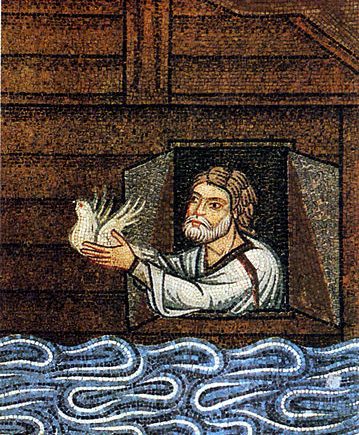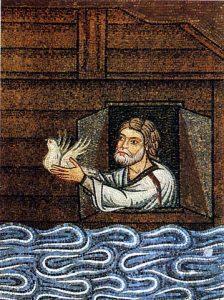The Hebraic, Eastern teaching style of the Bible often used imagery to explain theological truths. We can have a much greater understanding of the stories of the Bible if we look beyond the immediate events to see the patterns that keep coming up over and over again. For instance, consider this scene at the parting of the Jordan in the book of Joshua:
When the people set out from their tents to cross the Jordan with the priests carrying the ark of the covenant before the people, and when those who carried the ark came into the Jordan, and the feet of the priests carrying the ark were dipped in the edge of the water (for the Jordan overflows all its banks all the days of harvest), the waters which were flowing down from above stood and rose up in one heap, a great distance away at Adam, the city that is beside Zarethan; and those which were flowing down toward the sea of the Arabah, the Salt Sea, were completely cut off. So the people crossed opposite Jericho. And the priests who carried the ark of the covenant of the LORD stood firm on dry ground in the middle of the Jordan while all Israel crossed on dry ground, until all the nation had finished crossing the Jordan. (Joshua 3:14-17)
If we just read about the parting of the Jordan without thinking about any of the rest of the Bible, we miss 90 percent of what is going on. What other stories are reminiscent of this? The first thing that comes to mind is the parting of the Red Sea forty years earlier. In both instances it is clear God is present: before by the presence of the pillar of fire, and now by carrying the ark in front of them, which signified his presence as if he was walking ahead of them into the Jordan.
One interesting difference is that before, the people stood back while the wind blew to part the water, but this time God required them to set foot in the swollen river waters of the Jordan before he parted the river. Before, he did the miracle to give them faith, but now he required their faith to do the miracle. The steep banks of the flooding river Jordan would surely have swept them away, just as the Egyptians would have killed them before, but this time the fear was in following God, not in lingering behind. This was a test of whether they had learned what they spent forty years in the desert taking lessons on — how to trust the Lord.
A New Creation
 Beyond the parallels to the Red Sea crossing, we also see a really fascinating theme that runs through all of the Bible: the picture of God beginning a new creation. Genesis begins the story of creation with the Spirit of God “hovering over” the deep (tehom,) and one of his first acts of creation is the separation of water from water.
Beyond the parallels to the Red Sea crossing, we also see a really fascinating theme that runs through all of the Bible: the picture of God beginning a new creation. Genesis begins the story of creation with the Spirit of God “hovering over” the deep (tehom,) and one of his first acts of creation is the separation of water from water.
This imagery recurs over and over in the scriptures, every time God starts something new. There is a poetic motif in that the word for “the deep” is Tehom, which was symbolic of chaos. It is a picture of God conquering evil and chaos to bring order and a beautiful new thing into existence. The word for Spirit in Hebrew is ruach, which also means wind or breath. When God parts the waters by a great wind, it is a picture of God in the act of creating.
Where do we see this? First we see it in Genesis 1:1 of course, but only a few chapters later we see it again after the flood destroyed all of life on earth. In Genesis 8:1-3 God caused a wind, ruach, to pass over the earth, and restrained the waters of the deep, tehom. The flood waters recede, giving the world a new, clean beginning. This is also an image of cleansing too, as the world is cleansed of all of the evil that had been done because of the wickedness of mankind.
The next place this image occurs is in the parting of the Red Sea, as the wind, ruach, blows to separate the waters so that the Israelites can pass through. This marks the beginning of God’s new nation of Israel, who now would have their own sovereignty and identity as the people of God. Interestingly, the Israelites fall into sin, just as Adam and Eve did after God’s first act of creation, and judgment comes from God just as it did to the generations after Adam with the flood.
Looking back at the parting of the Jordan, we see that as they pass through the river Jordan, that once again God is parting the waters, and in a sense, recreating them as his people and cleansing them of their sin. It is then that they take on the covenant again, just like they did at Sinai, and make a clean beginning.
Yet another beginning
 There is one more significant scene in the Bible when we see this imagery of God at the waters: the baptism of Jesus. Here the heavens are parted (reminiscent of the waters being parted) and we see the Spirit of God “hovering” over, in the form of a dove, just as it hovered over the first waters of creation.
There is one more significant scene in the Bible when we see this imagery of God at the waters: the baptism of Jesus. Here the heavens are parted (reminiscent of the waters being parted) and we see the Spirit of God “hovering” over, in the form of a dove, just as it hovered over the first waters of creation.
Here is God’s new creation, God on earth in the form of the Son of Man. Interestingly, the next scene after his baptism is the temptation in the desert, like the temptation of Eve, and the Israelites in the desert, right after their “creation.”
Whereas as both Eve and the Israelites sinned, Jesus triumphed over sin, showing that he is God’s final and perfect creation, God himself in the form of a man.
~~~~
Photos: Dimnent Chapel [Public Domain], Giga Khurtsilava on Unsplash, ferdinand feng on Unsplash



